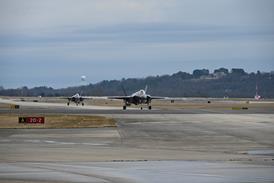Safety board demands post-service checks following probe into 1900D that crashed because of undetected error
A complete functional check should be carried out after maintenance on all "critical flight systems", says the US National Transportation Safety Board (NTSB). The board has made 25 recommendations following its investigation of the Air Midwest Raytheon Beech 1900D crash at Charlotte-Douglas airport, North Carolina on 8 January 2003.
The aircraft crashed out of control because of an undetected mistake during maintenance on the aircraft's elevator control system, according to NTSB investigators, and the two pilots and all 19 passengers were killed.
The NTSB has revealed that post-maintenance checks of flight-control functions were not previously required either by the aircraft's maintenance manual or by the US Federal Aviation Administration, and as a result the board has slammed both Raytheon and the FAA. It has recommended that such checks be included in all maintenance manuals, but also that they should be made mandatory by regulation. The FAA has not responded to the recommendations yet, but is required to do so within 90 days of the report. Meanwhile, the airline and maintenance contractor Raytheon Aerospace (now L-3 Vertex) have also been criticised for failing to provide adequate maintenance supervision and follow detailed established procedures.
The final accident report will be published in about five weeks, says the NTSB, but it released the probable cause, conclusions and recommendations after a board meeting last week. Newly revealed was the finding that the aircraft, which took off close to its maximum take-off weight, had been loaded unevenly, giving it a centre of gravity well aft of limits, which was disastrous considering the nature of the maintenance error.
Operating as US Airways Express flight 5481, the aircraft took off from Charlotte-Douglas, quickly adopted a high nose-up attitude, lost speed, stalled, crashed and burned out. Maintenance work just completed had left the elevator control system mis-rigged, so that the maximum elevator-down (pitch-down command) movement available was 7¡, "about one half of the downward travel specified by the aircraft manufacturer", says the report. This did not give the pilots enough pitch-down moment to overcome the effects of the tail-heavy loading. The manufacturer has since supplied to all 1900D operators a "travel board" - a template that can be used against control surfaces to check the correct degree of travel, which it says had always been available for purchase as a maintenance tool.
The FAA is at pains to point out that, although it has not responded to NTSB recommendations yet, it has already carried out a six-action programme to reduce the likelihood of a similar event. These include a 31 January 2003 emergency airworthiness directive to all operators of similarly rigged aircraft requiring a post-maintenance functional check to be carried out; increase of the mandatory assumed weight of carry-on baggage; and launch of a programme to establish how far above the assumed passenger weight the real average US passenger weight actually is.
DAVID LEARMOUNT / LONDON
Source: Flight International























